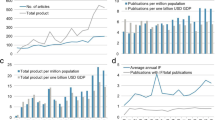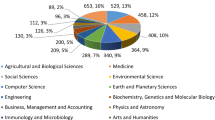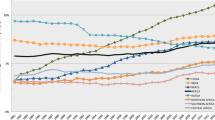Abstract
We compared scientific indicators related to Benin, Senegal and Ghana. We collected data from Web of Science and used bibliometric indicators like annual production, language and type of publication, citable and cited documents, citations, h-index, field share, specialization index, and international collaboration rate. Results show that Benin performs well regarding the percentage of citable and cited documents, the share of production and the specialization index in the fields of Natural sciences and Agricultural sciences; it occupies the median position with respect to the production and the specialization index in the fields of Engineering and technology on the one hand and Medical and health sciences on the other hand, behind Ghana and ahead Senegal. It lays however behind Ghana and Senegal with respect to the total output, citations per citable or cited documents, h-index, the share of production and specialization index in the fields of Social science and Humanities; it has the highest international collaboration rate. The study revealed that the three countries cooperated less, and only if a third western country intervened. It pointed out the role of Western countries in driving collaboration among developing countries.






Similar content being viewed by others
Notes
Resolution CM/Res.464 (XXVI) adopted by the African Unity Organisation (now African Union) Council of Ministers meeting in its twenty-sixth ordinary session in Addis-Ababa (Ethiopia) from 23 February to 1 March 1976. The countries’ list was updated in 2004.
CDS-ISIS is text database management software developed and distributed by UNESCO. (http://www.unesco.org/isis).
CDS/ISIS provides a programming language “designed to develop CDS/ISIS applications requiring functions which are not readily available in the standard package” (UNESCO 1989a). This programming language enables users to extend functions of the standard package, to make it more robust to meet users’ specific needs (Mêgnigbêto 1998).
« The formatting language allows you to define precise formatting requirement for data base records. Through this language, you may select one or more specific data elements in the order you want and optionally insert constant text of your choice, e. g. to label some or all the fields, as well as specify vertical or horizontal spacing requirements (…). The formatting language is therefore the core of many operations, and an efficient use of CDS/ISIS requires a thorough knowledge of this techniques » (UNESCO 1989b).
Power functions have to be preferred above other functions while fitting an Information Production Process; they enable direct comparison of results whether one works with small or high numbers (Egghe 2005, p. 2).
References
Boshoff, N. (2009). Neo-colonialism and research collaboration in Central Africa. Scientometrics, 81(2), 413–434.
Boshoff, N. (2010). South–South research collaboration of countries in the Southern African Development Community (SADC). Scientometrics, 84, 416–434.
Egghe, L. (2005). Power laws in the information production process: Lotkaian informetrics. Amsterdam: Elsevier Academic Press.
Gaillard, J. (2010). Le système national de recherche scientifique et technique au Bénin: un état des lieux. Paris: UNESCO.
Ghana Ministry of environment, science and technology. (2010). National science, technology and innovation policy. Accra: Ghana Ministry of environment, science and technology.
Gouvernement du Bénin. (2006). Politique nationale et grands axes de la recherche scientifique et technologique au Bénin. Cotonou: Gouvernement du Bénin.
Mahbuba, D., & Rousseau, R. (2010). Scientific research in the Indian subcontinent: Selected trends and indicators 1973–2007 comparing Bangladesh, Pakistan and Sri Lanka with India, the local giant. Scientometrics, 84(2), 403–420.
Mêgnigbêto, E. (1998). Le traitement informatique des particules nobiliaires: une expérience avec CDS/ISIS. Documentaliste-Sciences de l’information, 35, 321–325.
NEPAD Planning and Coordination Agency. (2010). African innovation outlook 2010. Pretoria: NEPAD Planning and Coordination Agency.
OCDE. (2011). Statistiques sur les apports de ressources aux pays en développement. Paris: OCDE.
OECD. (2007). Revised field of science and technology (FOS) classification in the Frascati manual (No. DSTI/EAS/STP/NESTI(2006)19/Final) (p. 12). Paris: OECD.
Pouris, A. (2010). A scientometric assessment of the Southern Africa development community: Science in the tip of Africa. Scientometrics, 85, 145–154.
Pouris, A., & Pouris, A. (2009). The state of science and technology in Africa (2000–2004): A scientometric assessment. Scientometrics, 79, 297–309.
SCImago. (2007). SJR—SCImago Journal & Country Rank. Retrieved from http://www.scimagojr.com.
Sock, O. (2004). Politique d’enseignement supérieur et de recherche scientifique au Sénégal: Situation actuelle et perspectives. Presented at the Fifth Annual Global Development Conference, New Delhi, India.
Testa, J. (2011). The globalization of Web of Science. Thomson Reuters. Retrieved from http://wokinfo.com/media/pdf/globalwos-essay.pdf.
Thomson Reuters. (2010). OECD Classification—Web of science subject headings. Thomson Reuters. Retrieved from http://incites.isiknowledge.com/common/help/h_field_category_oecd_wos.html.
Tijssen, R. J. W. (2007). Africa’s contribution to the worldwide research literature: New analytical perspectives, trends and performance indicators. Scientometrics, 71(2), 303–327.
Toivanen, H., & Ponomariov, B. (2011). African regional innovations systems: Bibliometric analysis of research collaboration patterns 2005–2009. Scientometrics, 88(2), 471–493.
UNESCO. (1989a). Mini-micro CDS/ISIS: Manuel de référence: version 2.3. Paris: UNESCO.
UNESCO. (1989b). Mini-micro CDS/ISIS: Pascal CDS/ISIS. Paris: UNESCO.
Author information
Authors and Affiliations
Corresponding author
Appendices
Appendix 1
See Table 8.
Appendix 2
See Table 9.
Appendix 3: Characteristics of the intra three countries collaboration
The six papers the three countries shared have 93 co-authors from 17 countries and 29 cities. Cotonou and Dakar represented Benin and Senegal respectively; Ghanaian cities occurred three times, namely Accra, Legon and Tamale. The publication of the 6 papers involved collaboration between 48 institutions; Figure 7 visualized the induced network. It shows two separate components, that is, two groups of institutions that didn’t cooperated in publishing at all. On the one hand, the component on the left counts 30 institutions: some western institutions (University of Arizona - USA, University of Leeds-UK, University of Paris- France, the National Aeronautics and Space Administration (NASA, USA), National Oceanic and Atmospheric Administration (NOAA, USA), Météo France (France), Institut de Recherche pour le Développement (IRD, France), Centre National de Recherche Scientifique (CNRS - France) and on the other hand, mainly national meteorology directorates of West African countries (Benin, Burkina Faso, Cote d’Ivoire, Niger, Ghana, Senegal, etc.). This component is related to 4 of the 6 papers Benin, Ghana and Senegal shared in common. Obviously, their output are related to Meteorology and Atmospheric Sciences according to the Web of Science subject areas, and therefore to Earth and related environment sciences according to the OECD FOS. The second component, on the right, groups together 18 institutions among which international organizations or associations with national representations to the West African countries: West Africa Project to Combat AIDS and STI (WAPCAS) in Quebec (Canada) and its national representations in West Africa (Benin, Ghana, Senegal, Mali, Cote d’Ivoire, Guinea, Burkina Faso, Togo) are the backbone of this component. They are responsible for 2 publications related to Medical and health sciences according to FOS.
Over the 48 institutions, 2 are based in each of the three countries, one from each component. The Benin-based are Direction nationale de la météorologie and WAPCAS-Bénin; the Senegal-based are Direction nationale de la météorologie and WAPCAS-Sénégal. Meteorology Service Department and WAPCAS-Ghana represent Ghana. Hence, the three countries based institutions worked together only if a Western or international organisation intervened. Therefore, Western or international organisations or institutions are drivers of collaboration.
The breakdown of the 164 papers resulting from bilateral collaboration with regard to the FOS gives: Natural sciences 16.46 % (27 papers), Engineering and technology 16.46 % (16 papers), Medical and health sciences 60.97 % (100 2 papers), Agricultural Sciences 16.46 % (27 papers), Social sciences 3.05 % (5 papers) and Humanities 0 %. 506 institutions cooperated to achieve these publications and shared up to 13 papers. Figure 8 visualizes the relationships with at least 4 papers. It shows two components: one smaller and one larger. The illustration of the bilateral collaboration is as follows: 1) Benin and Senegal: Université d’Abomey-Calavi shared 13 papers with Université Cheikh Anta Diop de Dakar and 8 papers with the Ecole Inter Etats de Sciences et Médécine Vétérinaires (EISMV, Senegal). IRD Bénin cooperated with the Université Cheikh Antan Diop de Dakar on 5 papers and with IRD-Sénégal on 4 papers. The Centre de Recherche entomologique de Cotonou and IRD Sénégal shared 4 papers. 2) Benin and Ghana: the collaboration involved the Université d’Abomey Calavi and the University of Ghana with 55 papers out of the 60 the two countries shared on the one hand and the Ministries of Health of the two countries (9 papers) on the other hand. This figure doesn’t show any Ghanaian institutions in their relationships with Senegalese. Apart from the main universities from each of the three countries, there is no direct cooperation between research institutions. Universities are the main actors of knowledge sharing within the three countries (Figs. 7, 8).
Appendix 4
See Table 10.
Rights and permissions
About this article
Cite this article
Mêgnigbêto, E. Scientific publishing in West Africa: comparing Benin with Ghana and Senegal. Scientometrics 95, 1113–1139 (2013). https://doi.org/10.1007/s11192-012-0948-6
Received:
Published:
Issue Date:
DOI: https://doi.org/10.1007/s11192-012-0948-6






